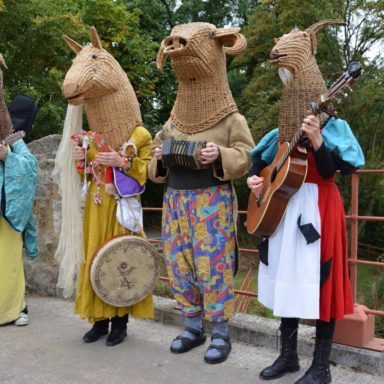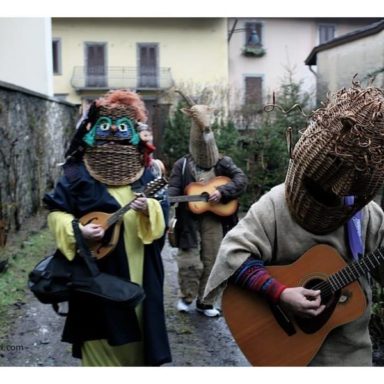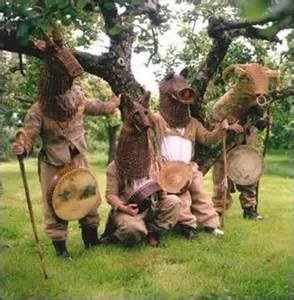Ireland’s oldest professional theatre in education company, the Armagh Rhymers is based in county Armagh. We spoke to founding member Dara Vallely to find out more about this award-winning, world-renowned folk theatre group.
Supporting social cohesion
Established in the 1970s, the Armagh Rhymers started by bringing folk theatre performances to schools in Northern Ireland. The organisation identified an area of social need and used the arts to bring communities together. It pioneered this approach in the Northern Ireland context. Dara explains: “At that time in the North, in the 70s…we started to bring Catholic and Protestant schools together and we were the first to do that…there was a lot of good will that we tapped into…We could go to a village and there would be a Catholic school at one end and a Protestant at other and they had never met”.
Ritual drama
Core to the Armagh Rhymers is the age-old folk theatre tradition of masked rhyming which blends dance, drama, music and song. Through re-imagining rhyming rituals performed by writers such as AE Russell and Yeats at their Rhymers Clubs, the Armagh Rhymer’s ritual drama celebrates Irish poets’ work. This has been recognised by major Irish poets namely Seamus Heaney, Michael Longley and John Montague.
Tradition-inspired costumes
A vital part of the Armagh Rhymer’s distinctiveness are the unique masks and costumes performers wear. They are based on traditional designs of the Wren Boys, Mummers and Strawmen, as well as characters from Celtic mythology and old Mummers plays that the Armagh Rhymers still perform. Most of the willow masks used were made by straw craft weaver, the late James Mulholland.
Multilingual, participatory performances
Performances are mostly in Irish or English but over the years the Armagh Rhymers has also used French, Italian, Welsh, Chinese and Korean. The organisation produces participatory theatre with strong audience engagement. Dara explains: “The audience is with us, they are not passive”.
Preserving old Irish customs
Aiming to celebrate and preserve old Irish customs and heritage, performances have a diverse range of inspirations. The Armagh Rhymers continue the ancient custom of performing rituals on festival days from both the Christian and pre-Christian periods in Ireland, such as Bealtaine, Samhain and St Brigid’s day. They also practice the house visiting tradition of the Mummers, Wren Boys or Strawmen. The main day for this tradition would be Lá an Droilín (Day of the Wren). This day is known in English as St. Stephen’s or Boxing Day and occurs the day after Christmas Day. On this day the Rhymers visit various houses and perform for the community, raising money for charity in the process. All of the Armagh Rhymers performances draw heavily on these ancient traditions.
Cooperative origins
The Armagh Rhymers was originally set up as a workers cooperative with seven founding members. Aligned with the cooperative principles, this drove the organisation to incorporate certain worker benefits. This included a pension fund for members, which was uncommon in arts organisations at the time. The Armagh Rhymers is now structured as a registered charity.
International networks
Through the years, the organisation has built a strong network of local, national and international connections. Its work has educational, social cohesion and entertainment functions. The Armagh Rhymers has been part of community projects with a range of groups, such as individuals with special needs and the elderly. It also performs at festivals and events both nationally and internationally. The Armagh Rhymers has a diverse repertoire suited to a range of audiences. “We have maybe 60 plays that we can pull out at the drop of a hat, handling science, social problems, themes like the famine, Brian Boru” according to Dara.
Performances at ritual sites
The Armagh Rhymers has also worked with tourists, such as through developing tours that include performances at ritual sites. Dara sees this as becoming increasingly important as part of cultural tourism, providing authentic and unique experiences for visitors. He explains: “A group of American tourists…we had them up on Carrickatuke hill… this is tied up with the Cúchulainn traditions…an ancient ritual site…. and we mimicked the killing of a bull…fire jumping…I think for the future people are looking for an authentic experience”.
Laoch na Laochra
With support from the Ultach Trust, the Armagh Rhymers has also been part of the development of the Laoch na Laochra touring exhibition. Based around the story of Cúchulainn, the exhibition combines a series of paintings by Dara, a performance and the Laoch na Laochra book by author Reamonn Ó Ciaráin and published by Gael Linn. The exhibition will feature as part of the Scottish International Storytelling festival in Edinburgh this October.




Discussion
You must be logged in to submit comments.
Add your comments here.
Maximum length of 500 characters